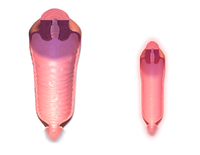
Photo from wikipedia
HIV incidence continues to be unacceptably high in Eastern and Southern Africa, with women disproportionately affected. An increased per-contact risk of HIV acquisition among African, Caribbean, and other Black (ACB)… Click to show full abstract
HIV incidence continues to be unacceptably high in Eastern and Southern Africa, with women disproportionately affected. An increased per-contact risk of HIV acquisition among African, Caribbean, and other Black (ACB) women has been associated with the higher prevalence of bacterial vaginosis (BV) in these communities, wherein the vaginal microbiota is predominated by diverse pro-inflammatory anaerobic bacteria. However, while the vaginal microbiota in BV-free women is typically predominated by one of several different Lactobacillus spp., the degree of HIV protection afforded by a Lactobacillus -predominant vaginal microbiota also varies considerably. Specifically, L. crispatus is associated with an immunoregulatory genital immune environment, exclusion of BV-associated bacteria, and reduced HIV risk. In contrast, less HIV protection or exclusion of BV-associated bacteria and fewer immune benefits have been associated with L. iners —which is unfortunately the most common Lactobacillus species among ACB women. These species-specific clinical differences are underpinned by substantial genomic differences between Lactobacillus species: for instance, the much smaller genome of L. iners lacks the coding sequence for D-lactic acid dehydrogenase and cannot produce the D-lactate isomer that enhances HIV trapping in mucus but encodes for epithelial cell toxins and stress resistance proteins that may enhance bacterial survival in the context of microbiota and environmental fluctuations. While more studies are needed to elucidate whether differences in HIV protection between Lactobacillus species are due to direct genital immune effects or the exclusion of proinflammatory BV-associated bacteria, the current body of work suggests that for BV treatment to succeed as an HIV prevention strategy, it may be necessary to induce a vaginal microbiota that is predominated by specific (non -iners ) Lactobacillus species. Video abstract
Journal Title: Microbiome
Year Published: 2021
Link to full text (if available)
Share on Social Media: Sign Up to like & get
recommendations!